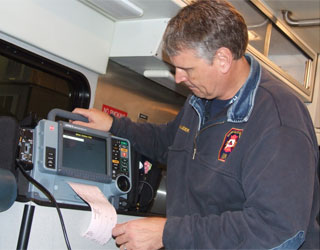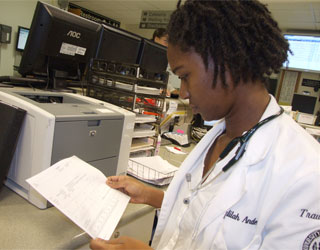Feature Story
Health Center Today, October 12, 2010
‘Door to Balloon’ in Record Time
By Chris DeFrancesco
A new system that can save crucial time in treating heart attack patients is in place at the UConn Health Center.
The technology enables the emergency department to receive data transmissions from paramedics in the field, allowing physicians to evaluate the readings and make determinations about the patient’s care before the ambulance arrives.
In cases where it is determined the patient is having a heart attack, the E.D. physician can mobilize the necessary clinical staff while the patient is still in transit.
"By the time the patient gets here, the doctors and nurses already know what they’re dealing with and can get that patient right up to the cath lab," says EMS coordinator Peter Canning.
The standard of care for what’s known as "door to balloon" time—the period covering the patient’s arrival at the hospital to the time a life-saving angioplasty is performed—is 90 minutes.
"Our first case was 23 minutes, door to balloon," Canning says. "That very well could be a record, certainly the fastest since I’ve been here."
Studies show every minute saved in door-to-balloon time increases the patient’s likelihood not just of survival but also of having normal heart function preserved.
That first case was September 28, days after the technology went online at the Health Center, in both the E.D. and paramedic vehicles.
In the field, Health Center paramedics using special heart monitors can take electrocardiogram readings and transmit the data to the E.D., where physicians can analyze the heart’s electrical activity and get a head start on coordinating care.
Health Center paramedics can transmit EKG readings to other area hospitals, and the Health Center can receive transmissions from other ambulances. Canning says within a year most ambulances in the area will have that capability.


Paramedic Mike Alger demonstrates a remote EKG transmission from an ambulance (left). The readings reach the emergency department before the patient does, so E.D. physicians like Dr. Khalilah Hunter-Anderson (right) can evaluate them and if necessary activate the cardiac catheterization lab before the patient arrives.
Photos by Chris DeFrancesco


